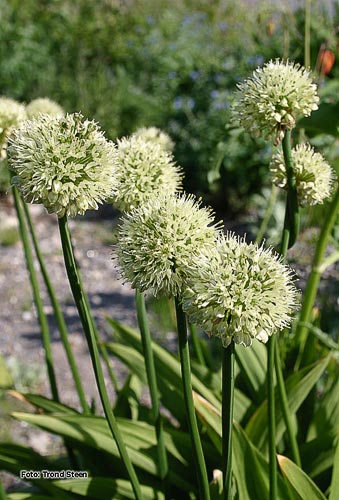Relatives
Allium victorialis L. - Alpine leek, victory onion.
Taxonomic position.
Family Alliaceae J. Agardh genus Allium L.Morphology and biology.
Perennial, bulbous plant. Geophyte. Bulbs are conical-cylindrical, 1-1.5 cm in diameter, inside grayish, fulvous, finely fascicular, fibrous coats, one or several bulbs settled on a slanted root. The stem, 30-80 cm tall, is covered for one third to one half of its height in violet axils. Leaves, usually 2-3 in number, are smooth, flat, broadly elliptical, with a well-expressed blade, 2-8 cm wide and 10-20 cm long, with an acuminate tip, leading to a petiole 3-6 cm long at the base. The umbel is spherical, dense. Pedicels are equal in length, longer than the perianth. Sepals are whitish green, 3-5 mm long; the outer ones are lanceolate, the inner ones ovate. Filaments are almost 1.5-2 times longer than the sepals. The capsule is trispermous. Seeds are rounded. Autochore. Blossoms in May-July, bears fruit in July-August. Chromosome number: 2n = 16, 32.Distribution.
European species. Central and Atlantic Europe, Mediterranean region, and the Caucasus (Ante-Caucasus, Daghestan, Eastern Transcaucasia).Ecology.
Mesophyte. Photophilous. Occurs in damp, alpine forests, as well as in forest and subalpine meadows.Utilization and economic value.
Food (vegetable) and source of vitamins. Fresh and salted plants are widely used as dressing, greens and preventive aid against scurvy. Contains plenty of ascorbic acid.References:
Brezhnev, D.D., Korovina, O.N. 1981. Wild relatives of cultivated plants in the flora of the USSR. Leningrad: Kolos, pp.99-100 (in Russian).Schmidt V.M., ed. 1990. Areas of distribution of medicinal plants and their relatives in the USSR (Atlas). 2nd edition (revised). Leningrad: Leningrad University Publishers, pp.21-23. (in Russian).
Vvedensky, A.I. 1935. Onion - Allium L. (Flora of the USSR, vol. IV.) Leningrad: Publishing House of the USSR Academy of Sciences, p.142. (in Russian).


